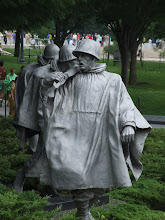
Amongst the landmarks are the Capitol building, seat of the US congress. Work began in 1795 leading to both wings being completed by the time of the war of 1812. In August 1814 British troops partially burnt the building. Further work resulted in the completion of the central rotunda in 1864 during the civil war.

The White house was begun in 1792 and has housed every US president since John Adams. It was completed in 1800 and like the capitol building partially burnt during the British occupation of Washington in 1814.
Ford's theatre (now a museum) has been

To either side of Lincoln are inscribed the key speeches of his presidency; the gettysburg address and the 2nd inauguration speech. Personally i found this monument one of the most moving in the whole of Washington, principally i think for the high moral ideals yet practical reasoning of Lincoln. Behind the monument is the bridge across the potomac to Arlington cemetery. Everything in this city is spread out so bring good walking shoes.

The cemetery was proposed by Quartermaster General Meigs in 1864 during the ACW. Meigs had recently lost his own son in the conflict and a national cemetery on the land of General Lee who had originally been offered command of the Northern forces was thought by many to be appropriate.
The cemetery has a wellcome centre which provides paper maps, which are generally useful listing some of the more famous incumbents, but actually finding their graves is a little more difficult. Key military incumbents include Maj Gen Phil Sheriden, Abner Doubleday not to mention numerous service personnel from the AWI onwards, including a separate section containing soldiers of the confederate states.
Other more recent conflicts are obviously represented by a significant array of monuments both in the cemetery and throughout Washington DC. Personally i found the most striking to be the US marine corps (Iwo Jima), for its sheer size and spectacle, and the Korean War monument for the gentle beauty of the simplistic yet moving platoon models.








No comments:
Post a Comment